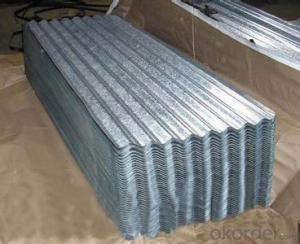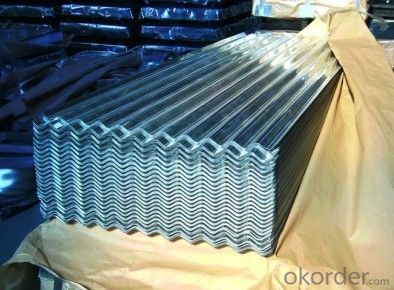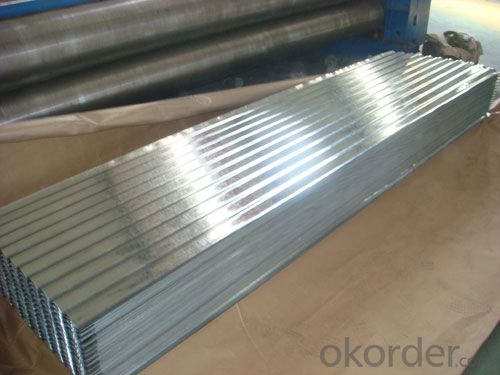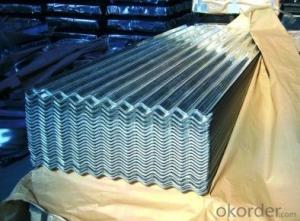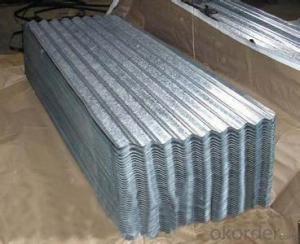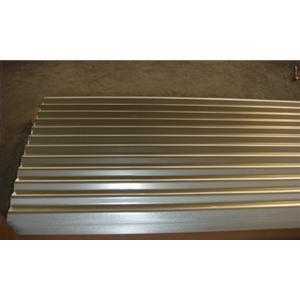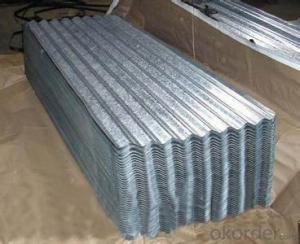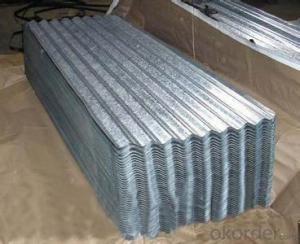Hot-Dip Galvanized Steel Roof of High Quality with Different Thickness
- Loading Port:
- Shanghai
- Payment Terms:
- TT OR LC
- Min Order Qty:
- 50 m.t.
- Supply Capability:
- 10000 m.t./month
OKorder Service Pledge
OKorder Financial Service
You Might Also Like
1. Hot-Dip Galvanized Steel Roof Description:
Hot-dip galvanized steel roof are available with a pure zinc coating through the hot-dip galvanizing process. It offers the economy, strength and formability of steel combined with the corrosion resistance of zinc. The hot-dip process is the process by which steel gets coated in layers of zinc to protect against rust. It is especially useful for countless outdoor and industrial application.
2.Main Features of the Hot-Dip Galvanized Steel Roof:
• Excellent process capability
• Smooth and flat surface
• Workability, durability
• Excellent heat resistance performance
• High strength
• Good formability
• Good visual effect
3.Hot-Dip Galvanized Steel Roof Images
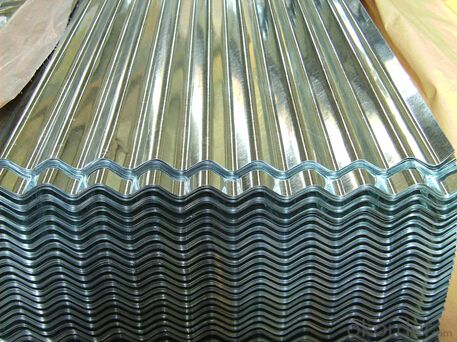

4.Hot-Dip Galvanized Steel Roof Specification
Material: Galvanized Sheet
Width: 650/800/890/900
Length: 1500/1800/2000/2400/3005/3600 or customized
Thickness: 0.2-2.0
Surface Treatment: Hot dipped/Bended
Application: warehouse; shelter; Commercial facilities; industrial facilities
5.FAQ of Hot-Dip Galvanized Steel Roof
Which payment term we can do?
L/C at sight or T/T.
What’s the basic material of this product?
Galvanized/Aluzinc Steel
What’s the coating composition of Hot-Dip Galvanized Steel Coil?
The coating composition is 55% aluminium in weight ratio, 43.4% zinc, and 1.5% silicon, with excellent corrosion and heat resistance performance.
- Q: How many percent carbon in low alloy steel and high alloy steel
- Steel is basically an alloy of iron and carbon that has more than 0% carbon and less than 2% carbon. The alloy of carbon and iron with more than 2% carbon is considered cast iron. The bessemer process converts cast iron to steel by injecting oxygen into molter cast iron to burn off the excess carbon. Steel is also modified by adding additional elements like silicon, molydenum, vanadium, chrome, etc.
- Q: How are steel coils used in the HVAC industry?
- Steel coils are commonly used in the HVAC industry for various purposes such as heat transfer, refrigerant circulation, and air conditioning. They are typically found in heat exchangers, condensers, and evaporators, where they help in transferring heat between air and refrigerant. Steel coils play a crucial role in maintaining the desired temperature and providing efficient cooling or heating in HVAC systems.
- Q: How are steel coils used in the packaging industry?
- Steel coils are used in the packaging industry primarily for the production of metal strapping and seals. These coils are unwound and processed to create strong and durable strapping materials that are used to secure and bundle various types of packaging, such as boxes, crates, and pallets. The steel coils provide excellent tensile strength and resistance to breakage, making them ideal for ensuring the safe transportation and storage of goods.
- Q: How are steel coils used in the manufacturing of agricultural equipment?
- Steel coils are used in the manufacturing of agricultural equipment as they provide strength, durability, and flexibility. These coils are typically formed, shaped, and welded to create various components like frames, brackets, and supports. The high strength of steel allows for the construction of heavy-duty machinery that can withstand the demanding conditions of agricultural operations. Additionally, the flexibility of steel coils allows for customization, enabling manufacturers to produce equipment that meets specific farming needs.
- Q: where can i find information online about steel residential homes that use solar energy?
- Sun energy technologies is not as commonplace as it's photovoltaic cousin, but is nevertheless an important piece in the actual sun power bigger picture. Solar thermal uses solar power in order to heat either drinking water or even atmosphere, that is after that transferred via collectors within order to it's location. With all the actual challenges we're dealing with in respect within order to global warming and also the stunning increase in air pollution caused by green house gas, solar energy as well as also the techniques utilized to funnel it have become vitally important to our long term which of our planet.
- Q: pros and cons of stainless steel and carbon steel swords
- Carbon is what samurais added to their swords to make them super strong. The iron ore was cooked in coal for days; the coal adds the carbon. Too much carbon or too little carbon is a bad thing so it was a very important process. I'd have to go with a sword with carbon.
- Q: How are steel coils used in the production of steel bolts?
- Steel coils are used in the production of steel bolts as they serve as the primary raw material. The coils are unwound and fed into a machine that cuts and shapes the steel into bolts of the desired size and shape. The coils provide a continuous supply of high-quality steel, ensuring the consistency and strength of the bolts produced.
- Q: How are steel coils used in the production of steel clips?
- Steel coils are used in the production of steel clips by being unwound and fed into a stamping machine, where the coils are cut into strips and then shaped into the desired clip form.
- Q: I want to know the special characters or the advantages of the corton steel. In what cases it is recommended to use?Thank you.
- *It is Corten steel.Grade A B. *Weathering steel, best-known under the trademark COR-TEN steel, is a group of steel alloys which were developed to obviate the need for painting, and form a stable rust-like appearance if exposed to the weather for several years. United States Steel Corporation (USS) holds the registered trademark on the name COR-TEN. Although USS sold its discrete plate business to International Steel Group (now Arcelor-Mittal) in 2003, it still sells COR-TEN branded material in strip-mill plate and sheet forms. In some areas it may be known without the hyphen as Corten steel. The original COR-TEN received the standard designation A242 (COR-TEN A) from the ASTM International standards group. Newer ASTM grades are A588 (COR-TEN B) and A606 for thin sheet. All alloys are in common production and use. It is a weather-resistant steel which is used in containers and hot flue gas line. The American Corten A Steel has a composition of C, 0.12; Si, 0.5; Cu, 0.5; Cr, 0.8; P, 0.1 and Mn, 0.5%. Although the tensile strength is less than 494 MPa the yield is in the region of 371 MPa. The combination of copper and phosphorus also increases the resistance to atmospheric corrosion which is important when thinner plates are used. The original steel A suffers a decrease in yield strength and notch ductility in thickness over 25 mm, to overcome which Corten B was developed-C 0.14; P 0.04; Mn 1.1; Cr 0.5; Cu 0.4; V 0.1; Bol Al 0.02. *COR-TEN A applies to plates up to 12.5mm in thickness, COR-TEN B applies to plates up to 50mm in thickness. *It has been used in bridge and other large structural applications such as the New River Gorge Bridge, the newer span of the Newburgh-Beacon Bridge, and the creation of the Australian Centre for Contemporary Art (ACCA). It is very widely used in marine transportation, in the construction of shipping containers.
- Q: How are steel coils used in the production of solar panels?
- Steel coils are not directly used in the production of solar panels. However, steel is typically used in the manufacturing of the structural frames and mounting systems for solar panels. These frames and mounting systems provide support and stability to the solar panels, ensuring their proper installation and long-term durability.
Send your message to us
Hot-Dip Galvanized Steel Roof of High Quality with Different Thickness
- Loading Port:
- Shanghai
- Payment Terms:
- TT OR LC
- Min Order Qty:
- 50 m.t.
- Supply Capability:
- 10000 m.t./month
OKorder Service Pledge
OKorder Financial Service
Similar products
Hot products
Hot Searches
Related keywords
